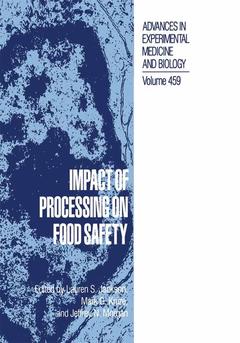Impact of Processing on Food Safety, Softcover reprint of the original 1st ed. 1999 Advances in Experimental Medicine and Biology Series, Vol. 459
Langue : Anglais
Coordonnateurs : Jackson Lauren S., Knize Mark G., Morgan Jeffrey N.

The contents of this book are the proceedings of the ACS symposium, "Impact of Processing on Food Safety," which was held April 16-17, 1997, at the American Chemical Society National Meeting in San Francisco, CA. This symposium brought together re searchers from diverse backgrounds in academia, government, and industry. Twenty speakers discussed topics ranging from the regulatory aspects of food processing to the microbiological and chemical changes in food during processing. The main goal of food processing is to improve the microbial safety of food by de stroying pathogenic and spoilage organisms. Food processing can also improve food safety by destroying or eliminating naturally occurring toxins, chemical contaminants, and antinutritive factors. Unfortunately, processing can also cause chemical changes that result in the formation of toxic or antinutritive factors. The purpose of this book is to summarize our knowledge of both the beneficial and deleterious effects of processing. Chapter I con siders the consumer's perceptions about food contaminants and food processing. Chapter 2 summarizes the effects of traditional and nontraditional processing methods on microor ganisms in food. Chapters 3-6 review the effects of processing on lipids (fatty acids and cholesterol) in food. Changes in the nutritive value of vitamins and minerals as a result of processing are discussed in chapter 7. Chapter 8 concentrates on how processing reduces the allergenicity of some foods.
1. Consumer Perceptions and Concerns about Food Contaminants.- 2. Microorganisms and Microbial Toxins.- 3. Food Processing and Lipid Oxidation.- 4. Impact of Processing on Formation of Trans Fatty Acids.- 5. Impact of High-Temperature Food Processing on Fats and Oils.- 6. Cholesterol Oxidation Products: Their Occurrence and Detection in Our Foodstuffs.- 7. The Impact of Food Processing on the Nutritional Quality of Vitamins and Minerals.- 8. Impact of Processing on Food Allergens.- 9. Postharvest Changes in Glycoalkaloid Content of Potatoes.- 10. Lysinoalanine in Food and in Antimicrobial Proteins.- 11. Influence of Feeding Alkaline/Heat Processed Proteins on Growth and Protein and Mineral Status of Rats.- 12. Food Heating and the Formation of Heterocyclic Aromatic Amine and Polycyclic Aromatic Hydrocarbon Mutagens/Carcinogens.- 13. Effects of Processing on Heavy Metal Content of Foods.- 14. Polychlorinated Biphenyls, Polybrominated Biphenyls, and Dioxin Reduction during Processing/Cooking Food.- 15. The Effect of Processing on Veterinary Residues in Foods.- 16. Effect of Processing on Fusarium Mycotoxins.
Date de parution : 09-2012
Ouvrage de 270 p.
17.8x25.4 cm
Thèmes d’Impact of Processing on Food Safety :
Mots-clés :
Alanin; Lipid; Nutrition; Oxidation; Toxin; Vitamin; allergy; food safety; microorganism
© 2024 LAVOISIER S.A.S.



